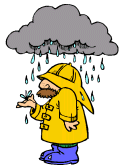
Precipitation
 All the forms of water that fall from the air to the Earth's surface are called precipitation. Whether the precipitation is snow, rain, sleet or hail depends on the temperature of the air that the water falls through. If the air is above freezing, the precipitation will most likely be rain. If the air is below freezing, the precipitation will most likely be snow. When air temperature is only a few degrees above freezing, precipitation may fall as sleet.
All the forms of water that fall from the air to the Earth's surface are called precipitation. Whether the precipitation is snow, rain, sleet or hail depends on the temperature of the air that the water falls through. If the air is above freezing, the precipitation will most likely be rain. If the air is below freezing, the precipitation will most likely be snow. When air temperature is only a few degrees above freezing, precipitation may fall as sleet.
Hail is most commonly formed within the cumulonimbus clouds of thunderstorms. Large updrafts of air can throw rain droplets high up into the tops of the cloud. Here, the temperature is well below freezing, and the droplets freeze. The droplets then fall and can become caught in further updrafts, adding a second coating of ice to make the hailstones larger. This cycle continues until the hailstones are too heavy to be lifted again. They then falls as hail. The stronger the updrafts in the cloud, the longer the hail develops, and the larger the hailstones are when they falls.
The amount of rain, sleet, snow or hail which falls in a specified time is expressed as the depth of water it would produce on a large, level impermeable surface. Usually it is expressed in millimetres although inches may sometimes be used. Precipitation is measured daily (24 hours) by means of a rain gauge. Todays rain gauges are simple to use with pre-calibrated scales on their sides. When measuring precipitation, certain precautions have to be taken against the effects of obstructions, wind, splashing and evaporation.
Websites
Other topics
Weather Dude
Wild Weather Page
Precipitation Types
Rain Gauges
WW2010
WW2010
USA Today
Franklin Institute
Franklin Institute
Rain
Hail
Snow
Weather Station
Collision/Coalescence
AtmoSphere
C@wley.Net
Introduction to Weather
Anticyclones
Beaufort Scale
Cirrus Clouds
Clouds
Cold Fronts
Condensation
Convection
Cooling Air
Cumulonimbus Clouds
Cumulus Clouds
Depressions
Dew
Dew Point
Energy
Evaporation
Fog
Forecasting
Fronts
Frost
Humidity
Hurricanes
Isobars
Measuring Weather
Meteorology
Monsoons
Movement of Air
Occluded Fronts
Precipitation
Pressure
Sea Breeze
Stability of Air
Stratus Clouds
Sunshine
Synoptic Charts
Temperature
Thunderstorms
Tornadoes
Uplift of Air
Warm Fronts
Water Cycle
Weather Symbols
Wind
 Print Topic
Print Topic